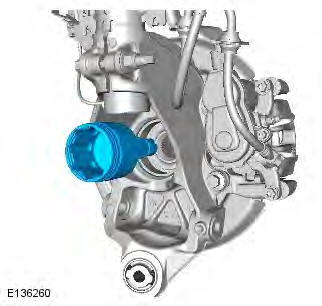Range Rover Evoque: Wheel Knuckle
Special Tool(s)
 205-857
205-857
Remover, Halfshaft
 JLR-204-804
JLR-204-804
Lever, Wheel Knuckle
Removal
CAUTIONS:
Nuts and bolts must be tightened with the weight of the vehicle on the suspension.
Do not allow halfshafts to hang unsupported at one end or joint damage will occur.
Make sure the halfshaft constant velocity (CV) joints do not over articulate. Failure to follow this instruction may result in damage to the CV joints.
Angularly adjusted roller (AAR) joints, used at the inboard end of some halfshafts have no internal retaining mechanism and can separate.
NOTE: If a new knuckle is installed a new wheel bearing must be installed.
All vehicles
1. Connect the diagnostic tool and set the electronic park brake (EPB) to the maintenance position.
2. WARNING: Make sure to support the vehicle with axle stands. Raise and support the vehicle.
3. Refer to: Wheel and Tire (204-04 Wheels and Tires, Removal and Installation).
4. CAUTIONS:
Do not use air tools to remove the nut.
Discard the nut.

5. NOTE: All wheel drive transmission illustrations shown, front wheel drive transmission is similar.

6.

7. NOTE: All wheel drive transmission illustrations shown, front wheel drive transmission is similar.

8. CAUTIONS:
Make sure that the driveshaft is supported with suitable retaining straps.
Do not use a hammer to detach the halfshaft from the hub assembly, failure to follow this instruction may result in damage to the halfshaft.
Special Tool(s): 205-857

Vehicles with front wheel drive transmission (FWD)
9. CAUTION: Do not use a hammer to detach the halfshaft from the hub assembly, failure to follow this instruction may result in damage to the halfshaft. Special Tool(s): 205-857

All vehicles
10. CAUTIONS:
Make sure that no load is placed on the brake hose.
Make sure that the brake hose is not twisted and is correctly located. Tie aside with a suitable tie strap.

11.

12.

13.

14.

15. CAUTION: Note the fitted position of the component prior to removal.

16. Special Tool(s): JLR-204-804

Vehicles with dynamic suspension
17.

18.

19. CAUTION: Note the fitted position of the component prior to removal.

20. Special Tool(s): JLR-204-804

21.

All vehicles
22.

23. NOTE: Do not disassemble further if the component is removed for access only. Remove the special tool.

Installation
All vehicles
1. NOTE: This step is only required if previously removed. Install the special tool.

2.

Vehicles with dynamic suspension
3. Remove the special tool.

4. CAUTION: Make sure the component is aligned as shown.

5. Torque: 110 Nm

6.

7.

All vehicles
8. Remove the special tool.

9. CAUTION: Make sure the component is aligned as shown.

10. Torque: 110 Nm

11.

12.

13.

14. CAUTION: Make sure that the brake hose is not twisted and is correctly located. Torque: 110 Nm

15.

Vehicles with front wheel drive transmission (FWD)
16.

All vehicles
17. NOTE: All wheel drive transmission illustrations shown, front wheel drive transmission is similar. Torque: 175 Nm

18. Torque: 270 Nm

19. NOTE: All wheel drive transmission illustrations shown, front wheel drive transmission is similar.

20. WARNING: Make sure that a new nut is installed.
CAUTIONS:
Install the halfshaft nut finger tight.
Do not use air tools to install the nut. Failure to follow this instruction may result in damage to the component.
Tighten the nut without the weight of the vehicle on the suspension.
Torque:
Stage 1: 100 Nm Nm
Stage 2: 90

